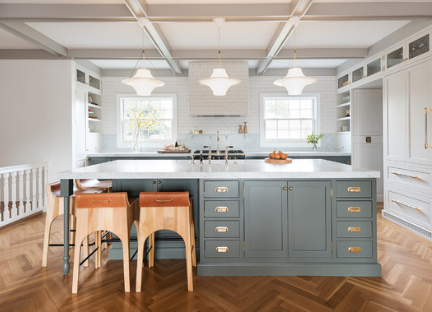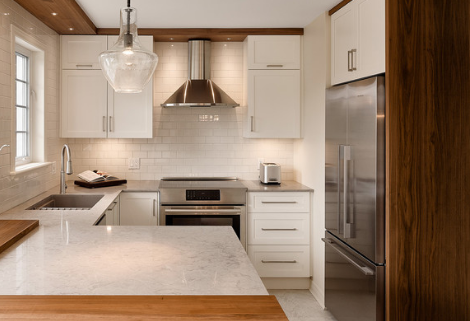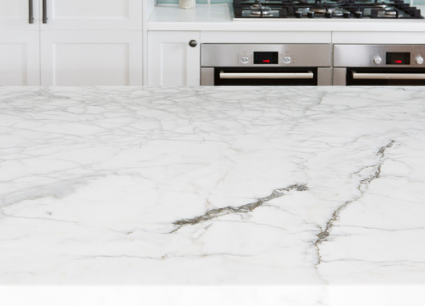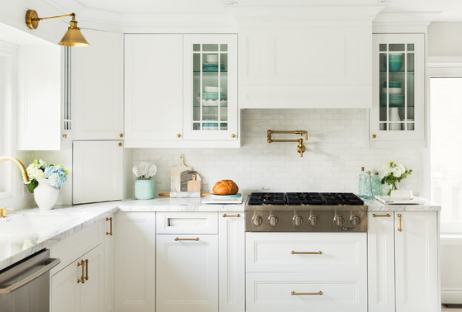The transitional style is a coveted kitchen look, but many people don’t even know how to define it, let alone put it together individually. There’s a lot of room for self-expression in this less modern, less traditional style, but there are a few common elements you can rely on to guide your design process. Take a look at my design tips to learn about some of the most essential elements of a transition style, and then you’re ready to create your own formula.
The Basics: A Mix of Old and New
Fundamentally, transitional style is about balancing traditional and modern elements to achieve an elegant style that doesn’t feel too old-fashioned or minimalist.

Often, this means taking an evocative traditional shape and applying a modern finish to it. For example, take a look at this beautiful bridge faucet. It’s a very traditional style faucet, but when used for an antique brass finish (as opposed to rustic black bronze), it feels very modern.
Must-Have: A Shaker Cabinet

Perhaps the best example of the balance between traditional and modern elements is the front of a shaker-style cabinet.
These doors and drawers usually have a flat panel in the middle, a raised flat bezel at the edges, and no “profile” (i.e., no fancy curved molding). It’s richer than a minimalist flat cabinet and doesn’t feel fussy.
This style of cabinetry has traditionally been wood-toned, just like the original Shakers were built on, but when painted in a crisp, modern hue, they achieve the perfect balance of old and new.
Color Palette: White and Gray with Neutrals

White shaker cabinets aren’t found in every transitional kitchen, but they’re certainly a popular choice. This may be because the freshness of white immediately makes any space feel more spacious.
Similarly, transitional kitchens aren’t strictly minimalist, so white is often mixed with gray, wood, seductive metallics, and other neutral colors and textural elements to form a friendly color palette.

Dark and charcoal greys are also popular, either in place of white cabinetry or added with white for a tuxedo effect. Deep, true neutral grey gives a classic, sophisticated feel without losing a sense of style.
To create a fun effect, dark gray chalkboard paint can give a relaxing feel to the room and avoid the atmosphere being too gloomy.

For those who prefer more color, blue and blue-gray are the perfect shades for fixed elements like cabinetry or floor tiles. This color makes the white porcelain and polished stone appear fresher, and it will match the changing hues for years to come.
Must-Have: Rich Wood

Mixing these expansive, crisp paints with wood brings a much-needed texture, so it’s common to find transitional kitchens with wooden floors, wooden bar stools, and slaughtering tables.
The floor panels of the herringbone layout bring an extra layer of richness, playing on the advantages of traditional parquet flooring in a way that does not feel stuck in the past.

Sometimes, the best way to use wood is unexpected, such as as as a vertical surface (like the side panels of a wall cabinet) or even as a decoration on the ceiling. This results in a natural texture that definitely won’t make your space feel dated.
Must-Have: Sparkling Stone

For quite some time, dark granite was widely regarded as the preferred choice for countertops. But for a coveted transitional style, marble or quartz with slight specks or veins can bring a sense of maturity without appearing heavy. It’s rich enough to accommodate more traditional elements, but also clear enough to work with modern accents. It’s perfect for all counters, or for using contrast stones or butcher blocks on the island for a pleasing contrast.
Must-have: Subway Tiles

When we talk about hard surfaces, here’s another key transitional style staple: subway tiles. Whether you choose seamless off-white cement grout or dark accents, the plain white metro tiles have a timeless elegance and simplicity that will keep you in style without competing to be the star of the show.
Of course, this is not to say that subway tiles are the only option. Another very popular option is to simply extend the counter material to the wall. This leans towards a more modern look, turning the counter and tailgate into a unique dramatic statement.
Mosaic Backsplashes

If you like the look of a mosaic backsplash, consider choosing a neutral, rich, classic patterned backsplash instead of a pop accent color. This is another great place to consider herringbone installations or tiles with interesting shapes, such as fish scales or hexagons. This will suit the transition style and help you avoid passing color trends in areas that are not easily updated.
Must-Have: Stainless Steel

Stainless steel appliances are highly sought after, especially in transitional kitchens, where they bring the appeal of a chef’s kitchen and help incorporate modern functionality into a somewhat traditional setting. In addition, the addition of some strong, brittle metal elements offsets the organic character of the wooden floors and stone counters. If you don’t currently have the budget (or desire) to use stainless steel appliances throughout the process, consider using this finish for just one appliance (like the collection) or through other décor (like cabinet hardware).
Brass

Brass has recently become a very popular transitional kitchen décor finish. It brings some golden charm and warmth to the space, but the tones are more muted than real gold.
Feel free to mix it with stainless steel and other cool silver metals. It makes great knobs, handles, lights, and even fixtures.
Must-Have: Modern Furniture

If you stick to only traditional décor, you may end up with a kitchen that transitions from transition to traditional whole. That’s where some great modern furniture comes in, such as high-tech extruded dining chairs, mid-century curved metal bar stools, cool industrial accent lamps, or minimalist dining tables.
Splurge: The Statement Pendant

Your lighting is a great place to splurge because it always naturally becomes the center of attention. In transitional styles, it’s common to see a sizable light in simple materials and shapes, relying on the drama of its size to catch your eye, rather than being so bold as to overwhelm your vision as you sit down for a snack.
Humble schoolhouses, domes or conical shapes are popular, as are glass spheres or lantern installations. Like most of the other elements described here, they have a subtle touch of tradition, but not too fussy or too ornate.
You can use lighting as an opportunity to introduce new accentuating materials or colors, such as subtle reds or coppers, or to match them with other finishes in the space. These tapered pendants match perfectly with the base of the stool.
The Finishing Touch: Traditional Rugs

As a custom finish for a transitional space, a warm, colourful traditional rug will ensure it doesn’t look too old-fashioned, bringing a touch of personality and a sense of effortless confidence. Try placing a long rug next to the island or even the main workspace, or a full rug on the dining table.



